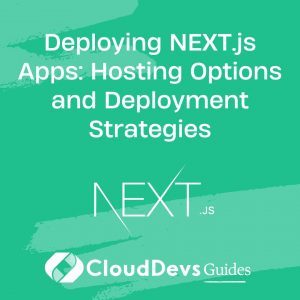Deploying NEXT.js Apps: Hosting Options and Deployment Strategies
In today’s fast-paced digital world, deploying web applications efficiently and reliably is crucial. For developers using NEXT.js, a popular React framework, understanding the available hosting options and deployment strategies is essential for a successful launch. In this guide, we will explore various hosting options and deployment strategies for NEXT.js apps, providing you with the knowledge to make informed decisions and ensure a smooth deployment process. Let’s dive in!
1. Hosting Options:
When it comes to hosting your NEXT.js app, there are several hosting options available, each with its own advantages and considerations. Let’s explore three common hosting options:
1.1. Static Hosting:
Static hosting involves serving pre-rendered HTML, CSS, and JavaScript files directly to the client without the need for server-side processing. Services like Vercel (formerly known as ZEIT) and Netlify are popular choices for static hosting. To deploy your NEXT.js app on a static hosting platform, follow these steps:
- Sign up for an account on your chosen static hosting platform.
- Connect your GitHub, GitLab, or Bitbucket repository to your hosting account.
- Configure the build settings to trigger a new build whenever changes are pushed to your repository.
- Define the necessary environment variables required for your app.
- Deploy your app and enjoy the benefits of fast, globally distributed static hosting.
1.2. Serverless Hosting:
Serverless hosting allows you to run your NEXT.js app as a serverless function, where the hosting provider takes care of infrastructure management, scaling, and availability. Popular serverless hosting platforms such as AWS Lambda, Google Cloud Functions, and Microsoft Azure Functions offer easy deployment options for NEXT.js apps. To deploy your app on a serverless hosting platform:
- Set up an account with your chosen serverless provider.
- Configure your function’s entry point to your NEXT.js app.
- Specify any necessary environment variables and dependencies.
- Deploy your app as a serverless function, and let the hosting provider handle the rest.
1.3. Containerized Hosting:
Containerized hosting allows you to package your NEXT.js app into a container image, making it portable and deployable across different environments. Platforms like Docker and Kubernetes are popular choices for containerized hosting. Here’s a basic deployment process for a containerized NEXT.js app:
- Containerize your app by creating a Dockerfile that specifies the necessary dependencies and build steps.
- Build the Docker image and push it to a container registry (e.g., Docker Hub, Google Container Registry).
- Set up your hosting environment (e.g., a Kubernetes cluster) and deploy your containerized app.
- Monitor and scale your app based on usage and demand.
2. Deployment Strategies:
Once you have chosen a hosting option, it’s essential to consider the most suitable deployment strategy for your NEXT.js app. Let’s explore three common deployment strategies:
2.1. Manual Deployment:
Manual deployment involves manually building your app and deploying it to your hosting environment. This strategy is suitable for small-scale projects or situations where full control over the deployment process is desired. Here’s a typical manual deployment workflow:
bash # Build the app $ npm run build # Start the app $ npm run start
2.2. Continuous Integration/Continuous Deployment (CI/CD):
CI/CD automates the deployment process by automatically building, testing, and deploying your NEXT.js app whenever changes are pushed to your repository. Popular CI/CD platforms like GitHub Actions, CircleCI, and Jenkins provide seamless integration with hosting platforms and can be configured to trigger deployments on every commit. Here’s an example GitHub Actions workflow for a NEXT.js app:
yaml
name: Deploy to Vercel
on:
push:
branches:
- main
jobs:
deploy:
runs-on: ubuntu-latest
steps:
- name: Checkout repository
uses: actions/checkout@v2
- name: Install dependencies
run: npm ci
- name: Build and deploy
run: npm run build && npx vercel --prod
2.3. Platform-Specific Deployment:
Certain hosting platforms provide specific deployment integrations tailored for NEXT.js apps. For example, Vercel provides a seamless integration with GitHub, GitLab, and Bitbucket, making it effortless to deploy your app directly from your repository. Other platforms may have similar integrations or specific deployment instructions in their documentation.
Best Practices for NEXT.js App Deployment:
To ensure a smooth deployment process for your NEXT.js app, consider the following best practices:
3.1. Environment Configuration:
Use environment variables to configure your app based on the deployment environment (e.g., API keys, database connections). Hosting platforms often provide ways to set environment variables securely, allowing you to manage sensitive information without exposing it in your codebase.
3.2. Build Optimization:
Utilize NEXT.js’s built-in optimizations to improve app performance. Enable features like server-side rendering (SSR), static site generation (SSG), and incremental static regeneration (ISR) where appropriate to reduce load times and improve search engine optimization (SEO).
3.3. Scaling Considerations:
Ensure your hosting environment is capable of handling increased traffic and scaling your NEXT.js app. Consider using auto-scaling features provided by hosting platforms or implementing horizontal scaling using containers or serverless functions.
Conclusion:
Deploying NEXT.js apps requires careful consideration of hosting options and deployment strategies. In this guide, we explored various hosting options such as static hosting, serverless hosting, and containerized hosting, along with deployment strategies including manual deployment, CI/CD, and platform-specific deployment. By following best practices and choosing the right approach for your app, you can ensure a smooth deployment process and deliver a performant and scalable experience for your users. Happy deploying!
Table of Contents









